| Listing 1 - 10 of 13 | << page >> |
Sort by
|
Book
ISBN: 9781407353951 1407353950 Year: 2020 Publisher: Oxford : BAR Publishing,
Abstract | Keywords | Export | Availability | Bookmark
 Loading...
Loading...Choose an application
- Reference Manager
- EndNote
- RefWorks (Direct export to RefWorks)
"Clovis was once considered to be the first universal lithic technology to evolve in North America, occurring between 11,050 to 10,800 radiocarbon years before present (14C yr BP). These early hunter-gatherers left behind a sparse material record of their occupation that consists primarily of stone tools and the manufacturing debris associated with their production. The trademark tool of this earliest lithic technology to evolve in North America is a fluted point named after its type site discovery in a quarry at Blackwater Draw Locality No. 1, near Clovis, a town in New Mexico. These artefacts were made by widely separated groups throughout North America. The fluted points from Nova Scotia are much the same as those from New Mexico, not identical, but the similarities outweigh the differences. Not only are the fluted points similar across North America, but other technological aspects of the Clovis culture, i.e. blades, unifacial tools, and osseous tools, appear to be equally similar and widespread. In this study, the author identifies a number of Clovis and Clovis variants from seven environmentally different regions across North America. This monograph analyses the variability of Clovis fluted points and the lithic raw materials that they were produced on from a continental perspective. Complementing the research is a digital photographic dataset of the Clovis fluted points discussed, available online." Source : publisher
Clovis points --- Clovis culture --- Stone implements --- Excavations (Archaeology) --- Antiquities, Prehistoric
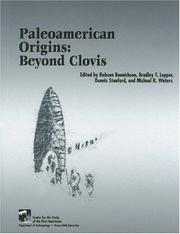
ISBN: 1585445401 9781585445400 9781603448123 Year: 2013 Publisher: College Station, TX : Center for the Study of the First Americans : Distributed by the Texas A & M University Press,
Abstract | Keywords | Export | Availability | Bookmark
 Loading...
Loading...Choose an application
- Reference Manager
- EndNote
- RefWorks (Direct export to RefWorks)
Paleo-Indians --- Clovis culture. --- Paleoecology --- North America --- Antiquities.
Book
ISBN: 1299052339 160344467X 9781603444675 1603442782 9781603442787 9781299052338 Year: 2011 Publisher: College Station : Texas A&M University Press,
Abstract | Keywords | Export | Availability | Bookmark
 Loading...
Loading...Choose an application
- Reference Manager
- EndNote
- RefWorks (Direct export to RefWorks)
Some 13,000 years ago, humans were drawn repeatedly to a small valley in what is now Central Texas, near the banks of Buttermilk Creek. These early hunter-gatherers camped, collected stone, and shaped it into a variety of tools they needed to hunt game, process food, and subsist in the Texas wilderness. Their toolkit included bifaces, blades, and deadly spear points. Where they worked, they left thousands of pieces of debris, which have allowed archaeologists to reconstruct their methods of tool production. Along with the faunal material that was also discarded in their prehistoric cam
Clovis culture --- Clovis points --- Excavations (Archaeology) --- Antiquities, Prehistoric --- Gault Site (Tex.) --- Bell County (Tex.) --- Antiquities.
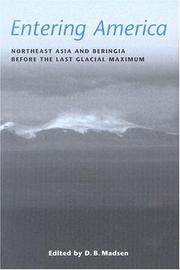
ISBN: 1607817853 9781607817857 0874807867 9780874807868 9781607810575 1607810573 Year: 2004 Publisher: Salt Lake City University of Utah Press
Abstract | Keywords | Export | Availability | Bookmark
 Loading...
Loading...Choose an application
- Reference Manager
- EndNote
- RefWorks (Direct export to RefWorks)
Paleo-Indians --- Human beings --- Paleoecology --- Human population genetics --- Clovis culture. --- Migrations. --- Asia --- North America --- Environmental conditions.
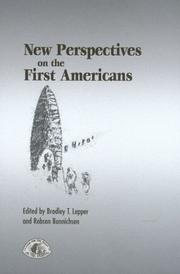
ISBN: 1585443646 Year: 2004 Publisher: College Station, TX : Center for the Study of the First Americans : Distributed by Texas A&M University Press,
Abstract | Keywords | Export | Availability | Bookmark
 Loading...
Loading...Choose an application
- Reference Manager
- EndNote
- RefWorks (Direct export to RefWorks)
Clovis culture. --- Paleo-Indians --- Culture Clovis --- Indiens du paléolithique --- North America --- Amérique du Nord --- Antiquities. --- Antiquités
Book
ISBN: 1623492289 1623492017 1322883963 9781623492281 9781623492014 Year: 2014 Publisher: College Station
Abstract | Keywords | Export | Availability | Bookmark
 Loading...
Loading...Choose an application
- Reference Manager
- EndNote
- RefWorks (Direct export to RefWorks)
Clovis culture --- Antiquities, Prehistoric --- Clovis points --- Clovis blades --- Prehistoric antiquities --- Prehistoric archaeology --- Prehistory --- Indians of North America --- Projectile points --- Stone implements --- Prehistoric peoples --- Paleo-Indians --- Implements
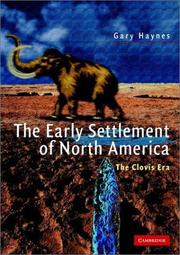
ISBN: 0521524636 0521819008 Year: 2002 Publisher: Cambridge ; New York : Cambridge University Press,
Abstract | Keywords | Export | Availability | Bookmark
 Loading...
Loading...Choose an application
- Reference Manager
- EndNote
- RefWorks (Direct export to RefWorks)
Clovis culture. --- Clovis points --- Hunting and gathering societies --- Mammoths. --- Mastodons --- Animal remains (Archaeology) --- Culture Clovis --- Pointes de Clovis --- Chasseurs-collecteurs --- Mammouths --- Mastodontes --- Restes d'animaux (Archéologie) --- Classification. --- Classification --- Restes d'animaux (Archéologie)
Book
ISBN: 1280095792 9786613520470 0520949676 9781280095795 9780520227835 0520227832 9780520949676 Year: 2012 Publisher: Berkeley University of California Press
Abstract | Keywords | Export | Availability | Bookmark
 Loading...
Loading...Choose an application
- Reference Manager
- EndNote
- RefWorks (Direct export to RefWorks)
Who were the first humans to inhabit North America? According to the now familiar story, mammal hunters entered the continent some 12,000 years ago via a land bridge that spanned the Bering Sea. Distinctive stone tools belonging to the Clovis culture established the presence of these early New World people. But are the Clovis tools Asian in origin? Drawing from original archaeological analysis, paleoclimatic research, and genetic studies, noted archaeologists Dennis J. Stanford and Bruce A. Bradley challenge the old narrative and, in the process, counter traditional-and often subjective-approaches to archaeological testing for historical relatedness. The authors apply rigorous scholarship to a hypothesis that places the technological antecedents of Clovis in Europe and posits that the first Americans crossed the Atlantic by boat and arrived earlier than previously thought. Supplying archaeological and oceanographic evidence to support this assertion, the book dismantles the old paradigm while persuasively linking Clovis technology with the culture of the Solutrean people who occupied France and Spain more than 20,000 years ago.
Clovis culture. --- Human beings --- Indians of North America --- Paleo-Indians --- Glacial epoch --- Ice Age --- Geology, Stratigraphic --- Paleo-Americans --- Paleo-Amerinds --- Paleoamericans --- Paleoamerinds --- Paleoindians --- Stone age --- Indians --- Prehistoric peoples --- Transatlantic influences on Indians --- Human geography --- Migrations of nations --- Migrations. --- Transatlantic influences. --- Origin. --- america. --- american culture. --- ancient history. --- ancient world. --- archaeologists. --- archaeology. --- asia. --- atlantic ocean. --- bering sea bridge. --- clovis culture. --- clovis tools. --- early peoples. --- europe. --- france. --- genetic studies. --- historical relatedness. --- human history. --- indigenous peoples. --- new world. --- nonfiction. --- north america. --- oceanography. --- paleoclimatic research. --- paleontology. --- prehistoric culture. --- prehistory. --- solutrean people. --- spain. --- stone tools. --- tribal hunters.
Book
ISBN: 9781623497507 1623497507 9781623497491 Year: 2019 Publisher: College Station
Abstract | Keywords | Export | Availability | Bookmark
 Loading...
Loading...Choose an application
- Reference Manager
- EndNote
- RefWorks (Direct export to RefWorks)
Clovis culture --- Antiquities, Prehistoric --- Excavations (Archaeology) --- Gault Site (Tex.) --- Bell County (Tex.) --- Antiquities. --- Archaeological digs --- Archaeological excavations --- Digs (Archaeology) --- Excavation sites (Archaeology) --- Ruins --- Sites, Excavation (Archaeology) --- Archaeology --- Prehistoric antiquities --- Prehistoric archaeology --- Prehistory --- Prehistoric peoples --- Paleo-Indians --- Bell Co., Tex. --- Texas --- Antiquities
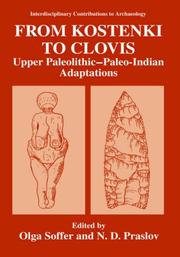
ISBN: 030644271X 1489911146 148991112X Year: 1993 Publisher: New York, NY : Plenum Press,
Abstract | Keywords | Export | Availability | Bookmark
 Loading...
Loading...Choose an application
- Reference Manager
- EndNote
- RefWorks (Direct export to RefWorks)
Paleolithic period --- Paleo-Indians. --- Paléolithique --- Indiens du paléolithique --- Europe --- Russia (Federation) --- North America --- Russie --- Amérique du Nord --- Antiquities. --- Antiquités --- Paléolithique --- Indiens du paléolithique --- Amérique du Nord --- Antiquités --- Kostienkien --- Culture Clovis --- Préhistoire --- Clovis culture --- Stone age --- Études transculturelles --- Paleo-Indians --- Eolithic period --- Old Stone age --- Palaeolithic period --- Paleo-Americans --- Paleo-Amerinds --- Paleoamericans --- Paleoamerinds --- Paleoindians --- Indians --- Prehistoric peoples --- Kostienkien. --- Culture Clovis. --- Préhistoire --- Études transculturelles
| Listing 1 - 10 of 13 | << page >> |
Sort by
|

 Search
Search Feedback
Feedback About UniCat
About UniCat  Help
Help News
News